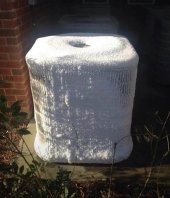Actually, reverse cycle heat pump's outside coil is not supposed to go below about 30 degs F. When they hit 30+/-2 degs they go into a defrost mode which just puts the reversing valve back to air conditioner cooling mode to warm up outside coil and turns on auxiliary electric heat strips at the top of inside air handler to keep the inside blower air from getting too cold during defrost. It usually only takes a couple of minutes to get outside coil warm enough to melt off any ice starting to build up. The trick is the unit must do defrosting often enough to prevent any significant amount of ice buildup. The defrost controller often has a timer that prevents unit from jumping back into defrost too soon after completing last defrost cycle even if coil drops below 30 degrees, as it is unlikely much ice has built up in a short time since last defrost cycle.
Depending on outside temp and relative humidity they can get overwhelmed. The outside unit defrost function only has ability to detect outside coil temperature and a not very accurate refrigerant pressure switch on outside coil lines. It cannot directly detect ice. When superheat pressure gets too low on outside coil, indicating likely freeze up, they give up and shut down, turning over inside heating solely to electric heat strips.
Mini-splits reverse cycle heat pumps often do not have auxiliary electric heat strips in inside unit.
A good install design selects the wattage of inside electric heat strips based on typical local weather conditions. Larger wattage electric heat strips should be installed in locations likely to get colder, high relative humidity, outside conditions.
Picture shows a unit that the defroster got overwhelmed. It should have given up long before it got this bad. Maybe the owner had lawn sprinklers programmed to turn on during the night in attempt to protect their plants from freeze damage, putting a lot of local humidity in air.
View attachment 105852



